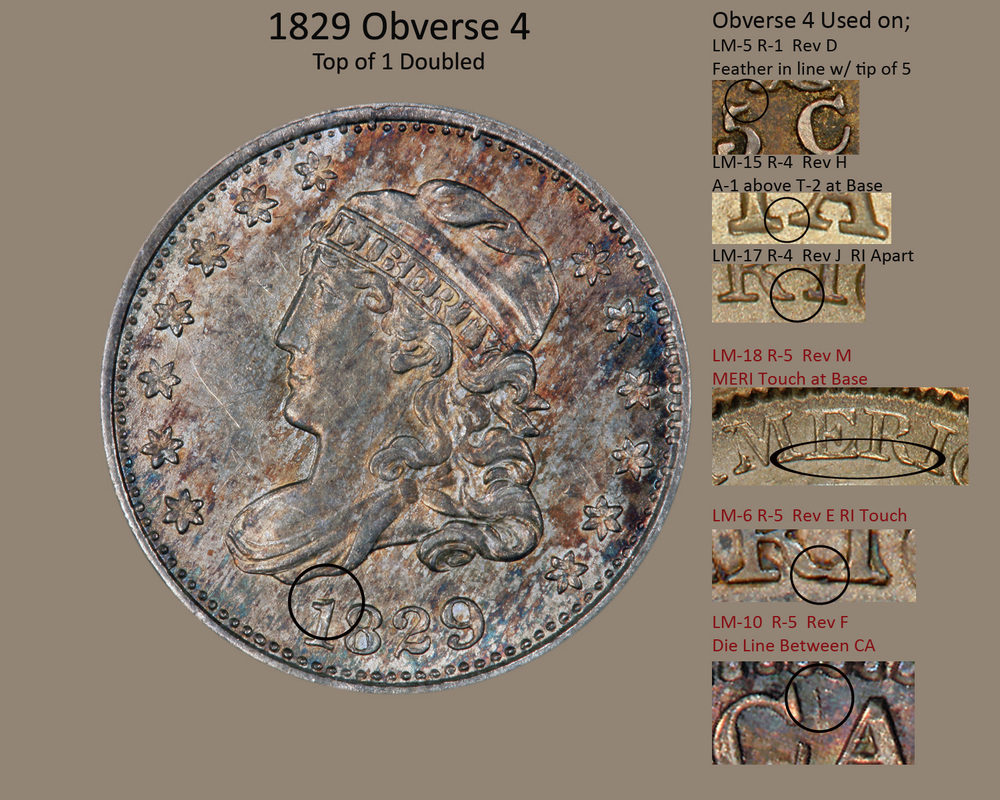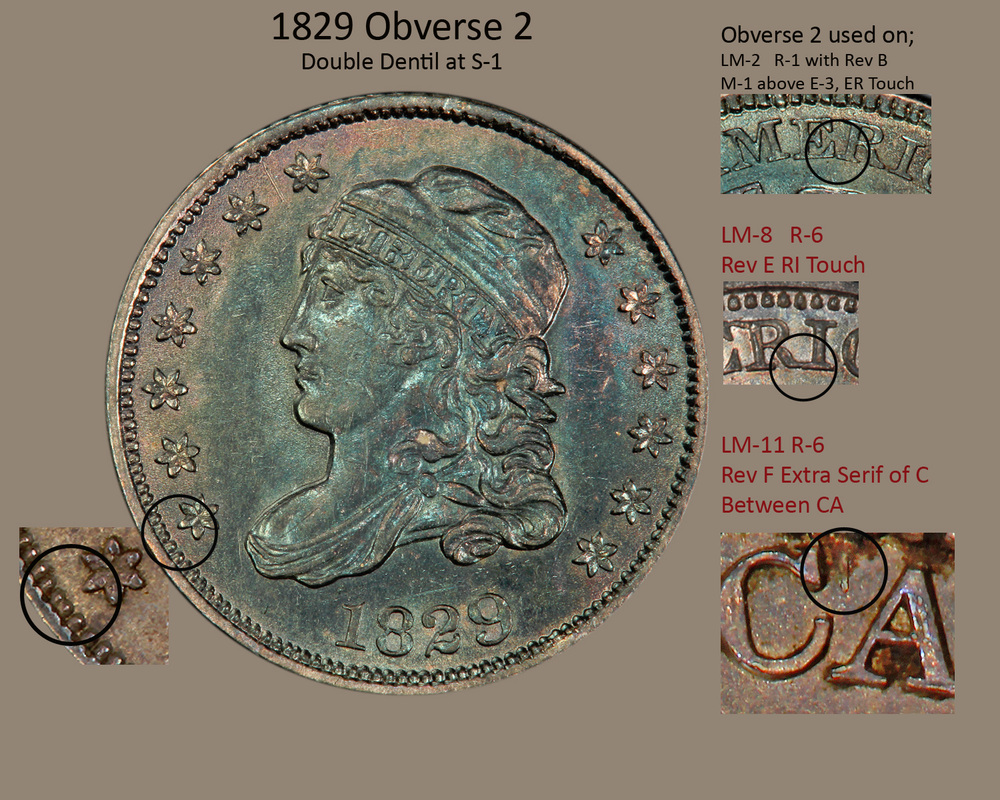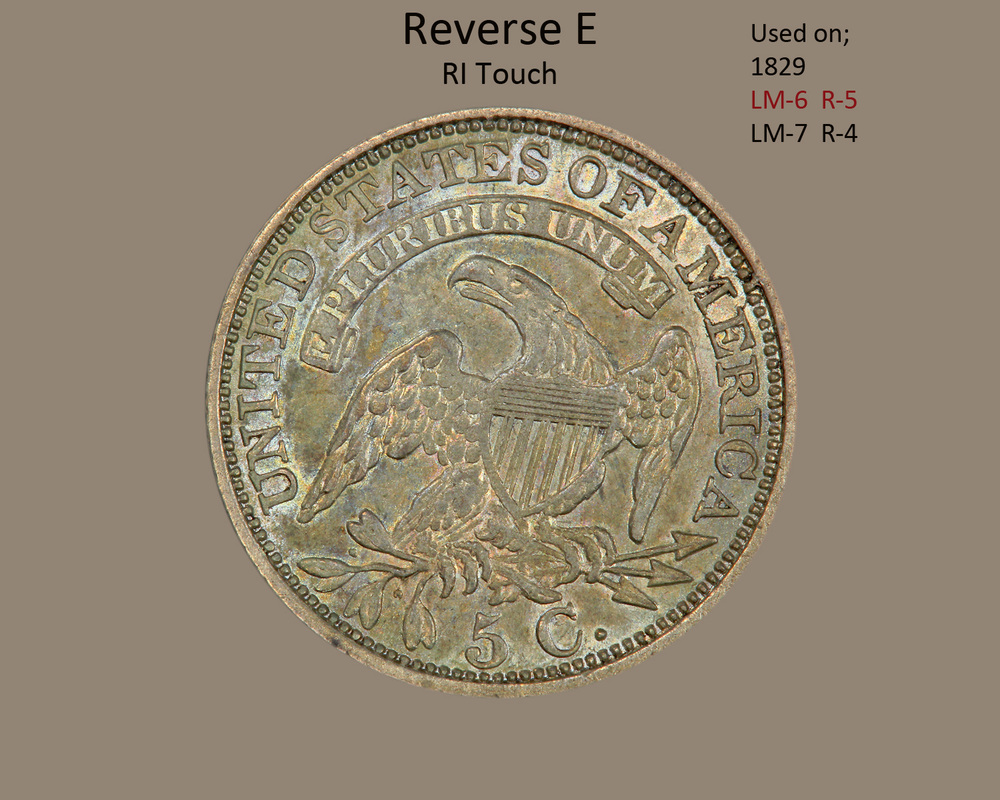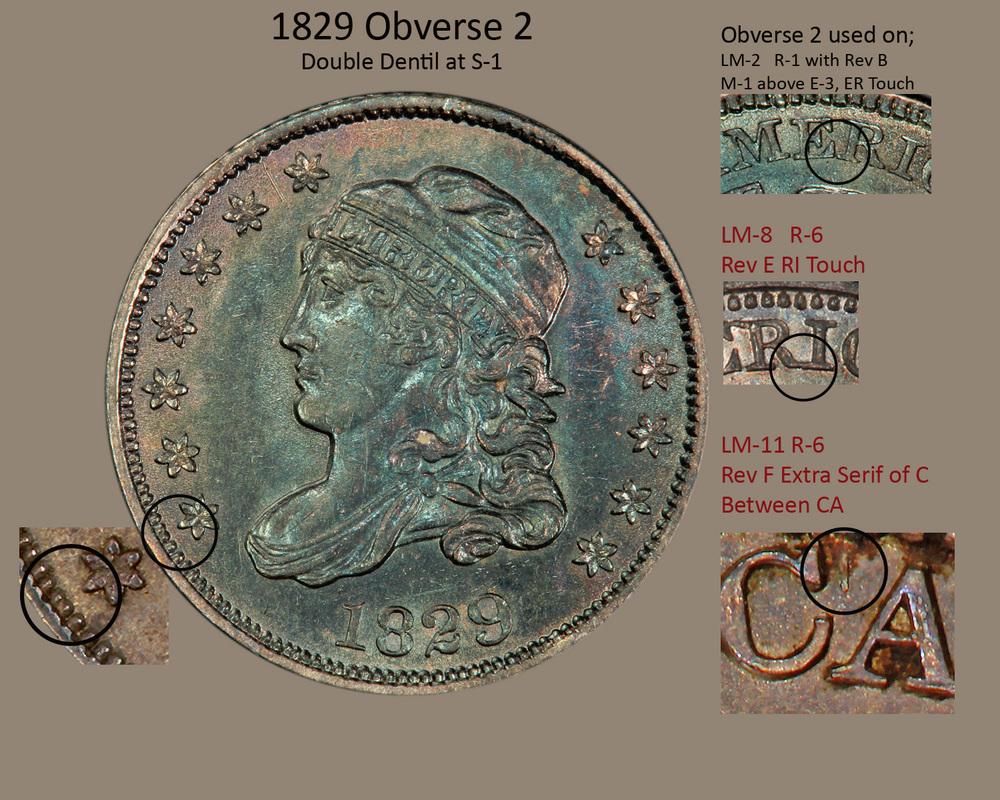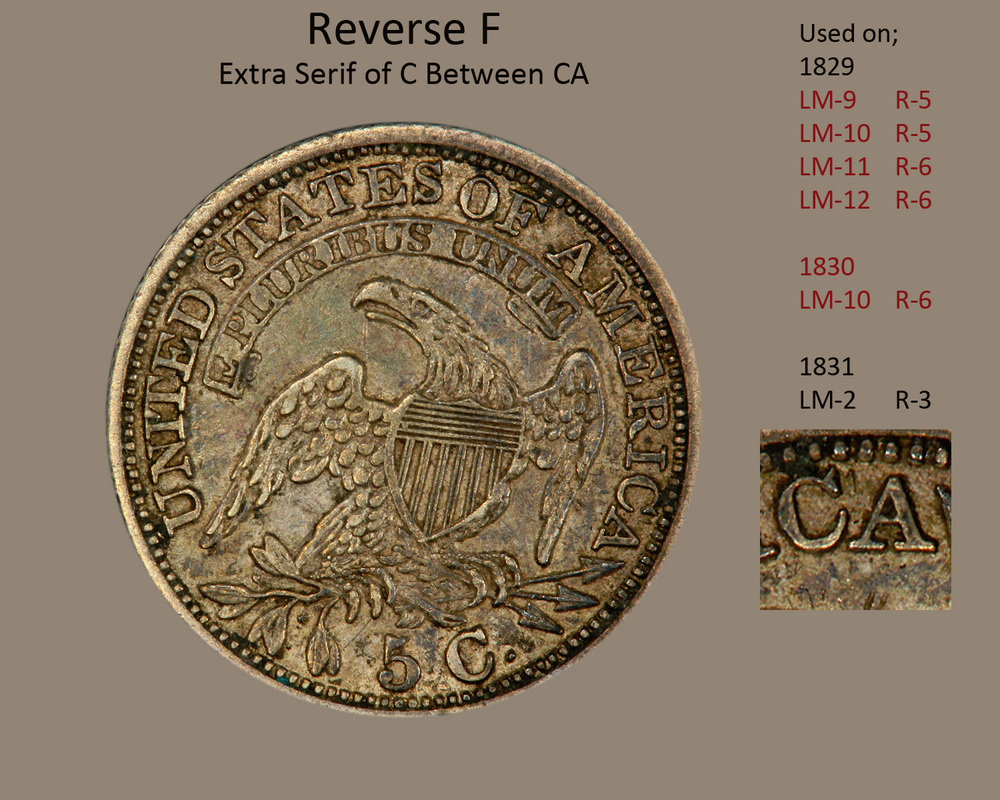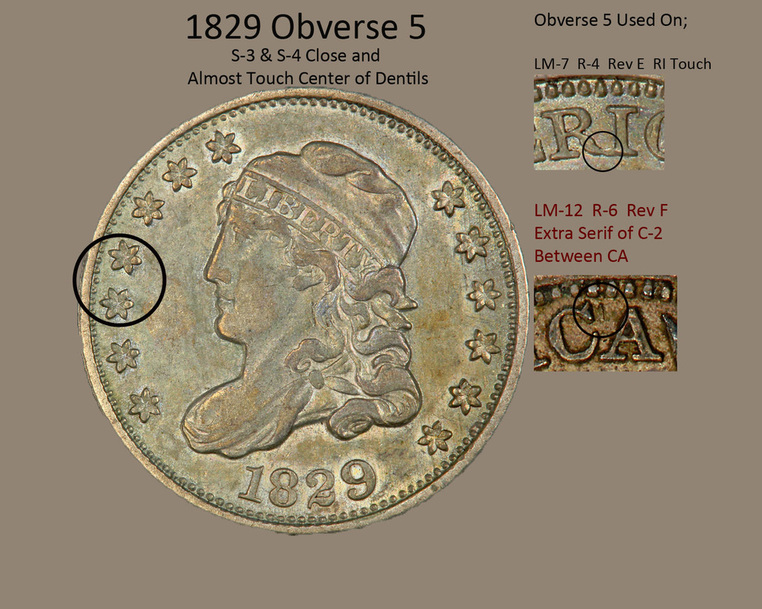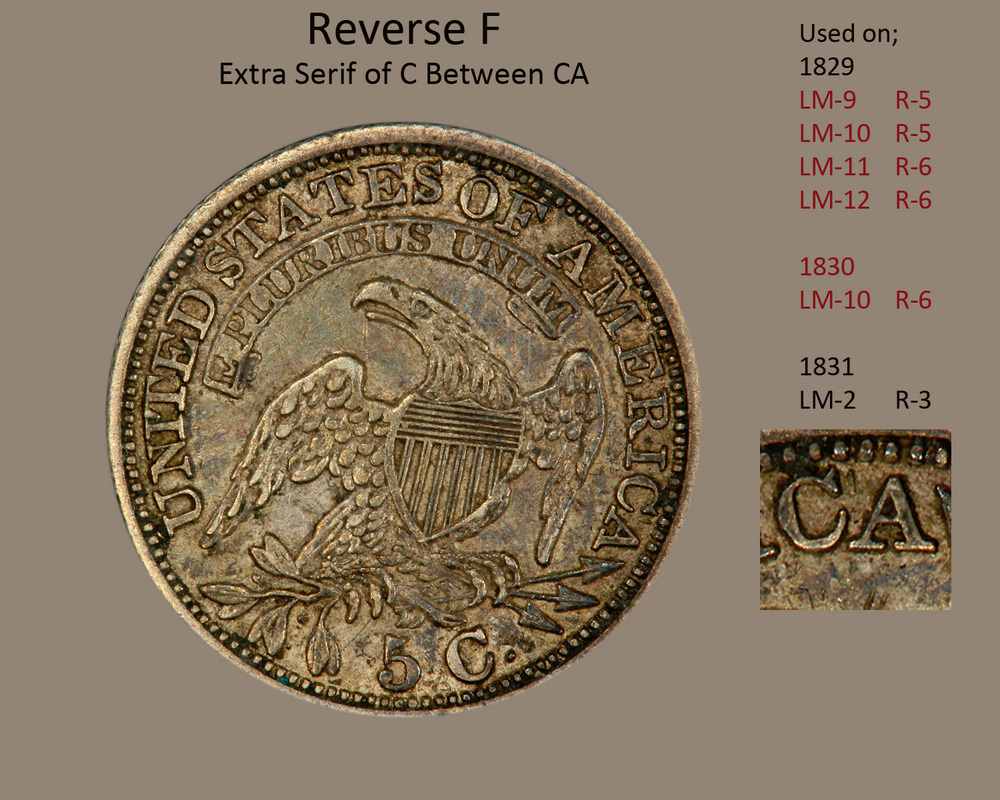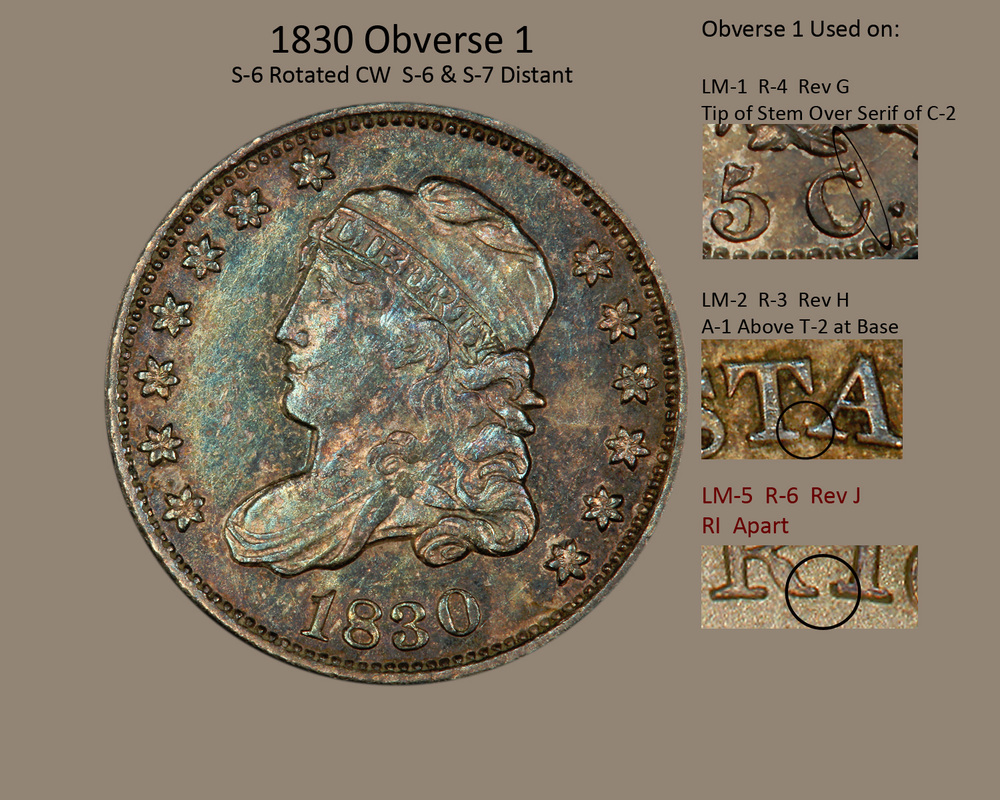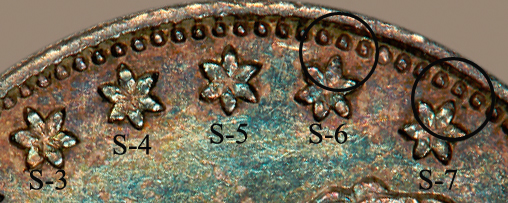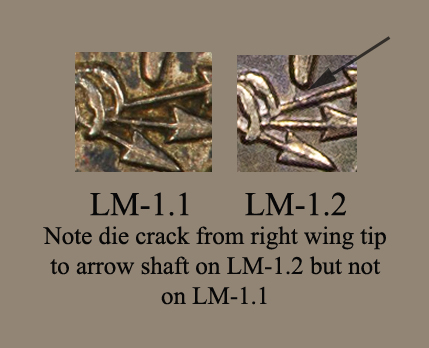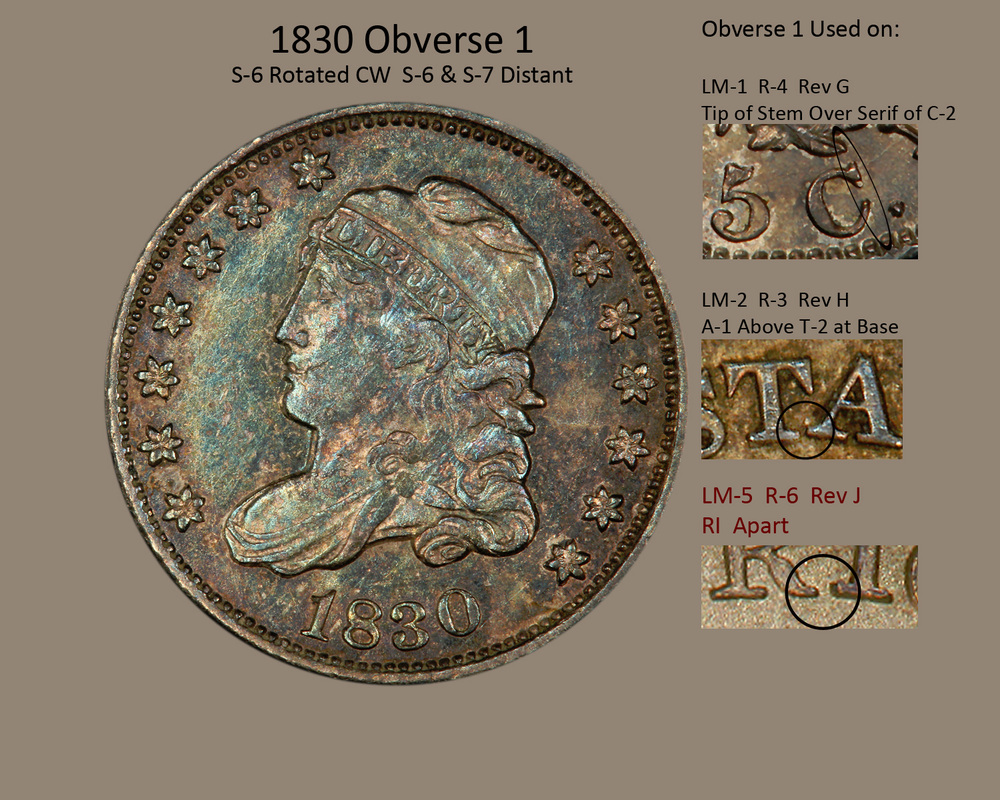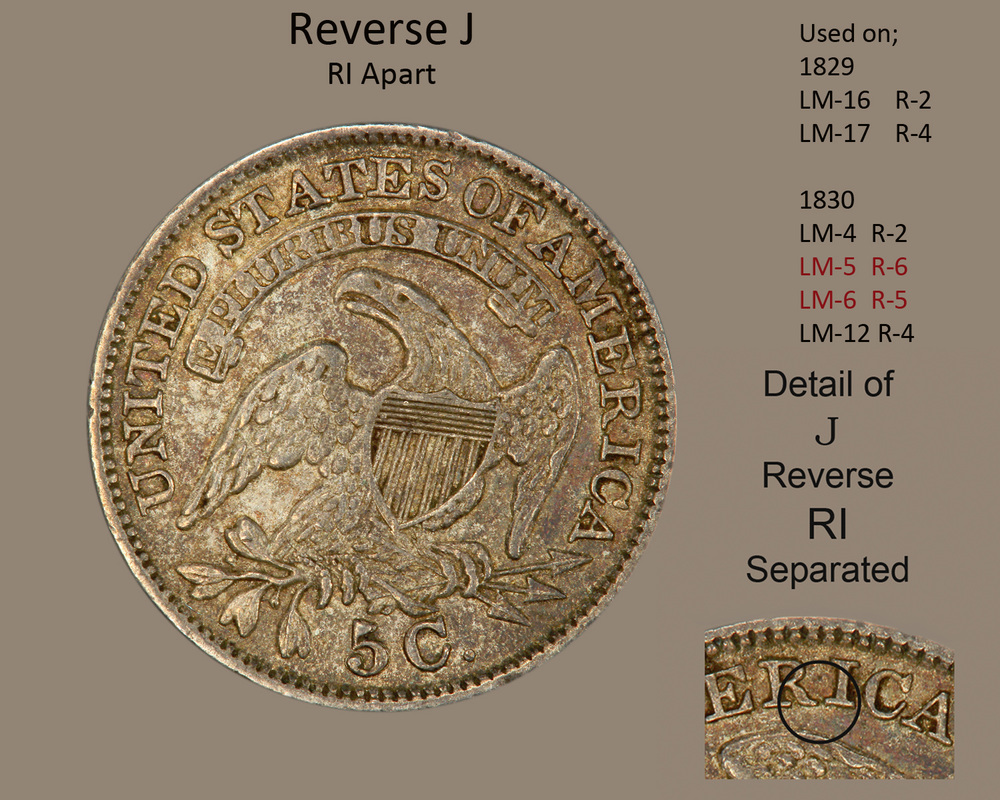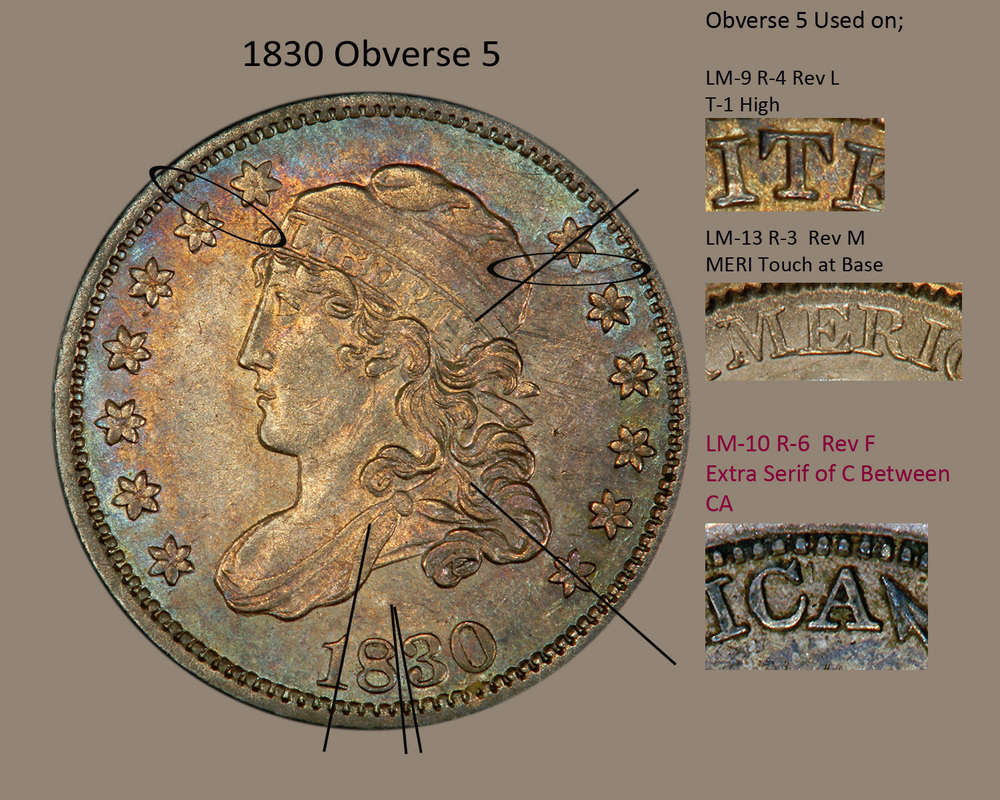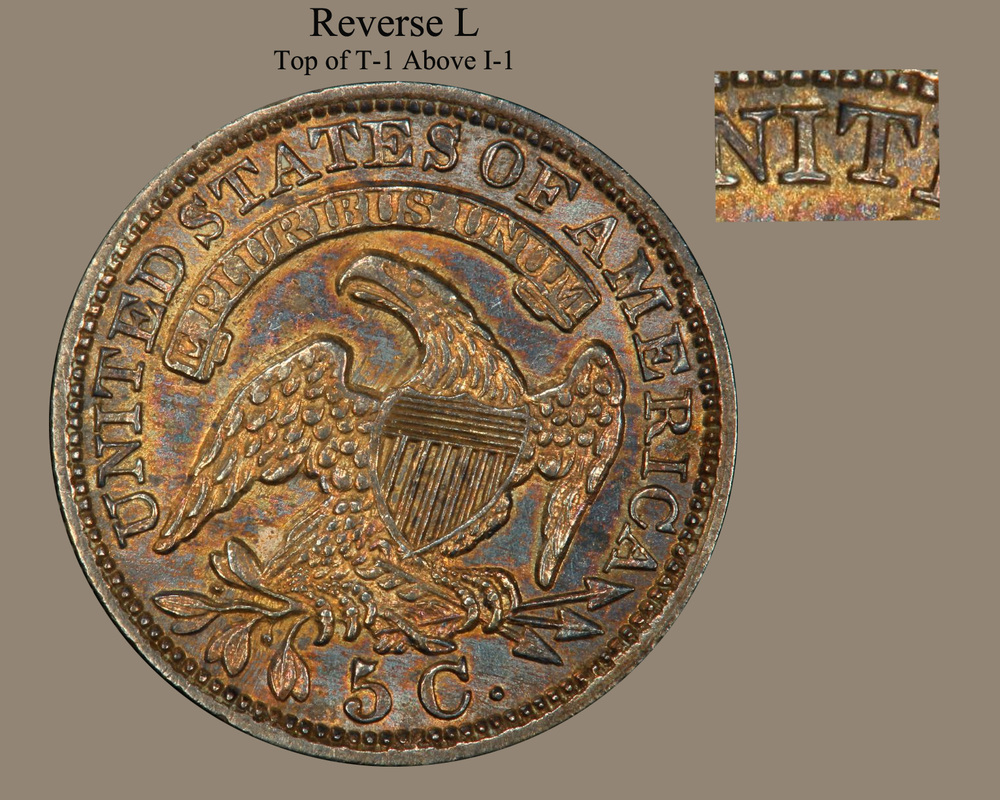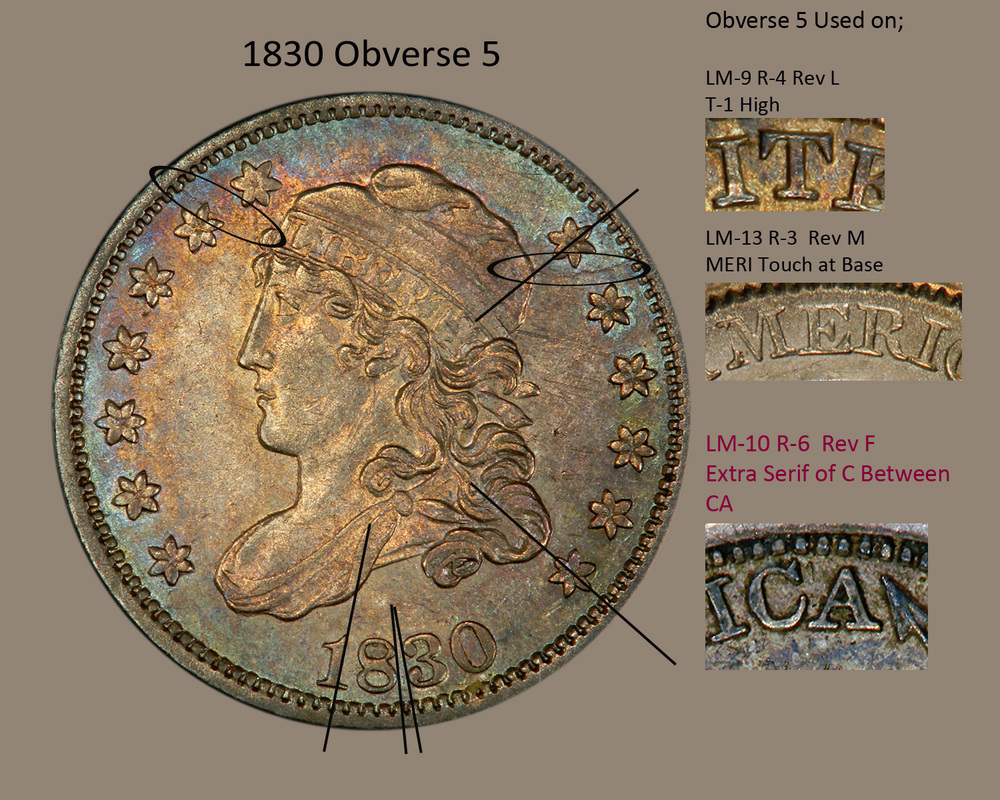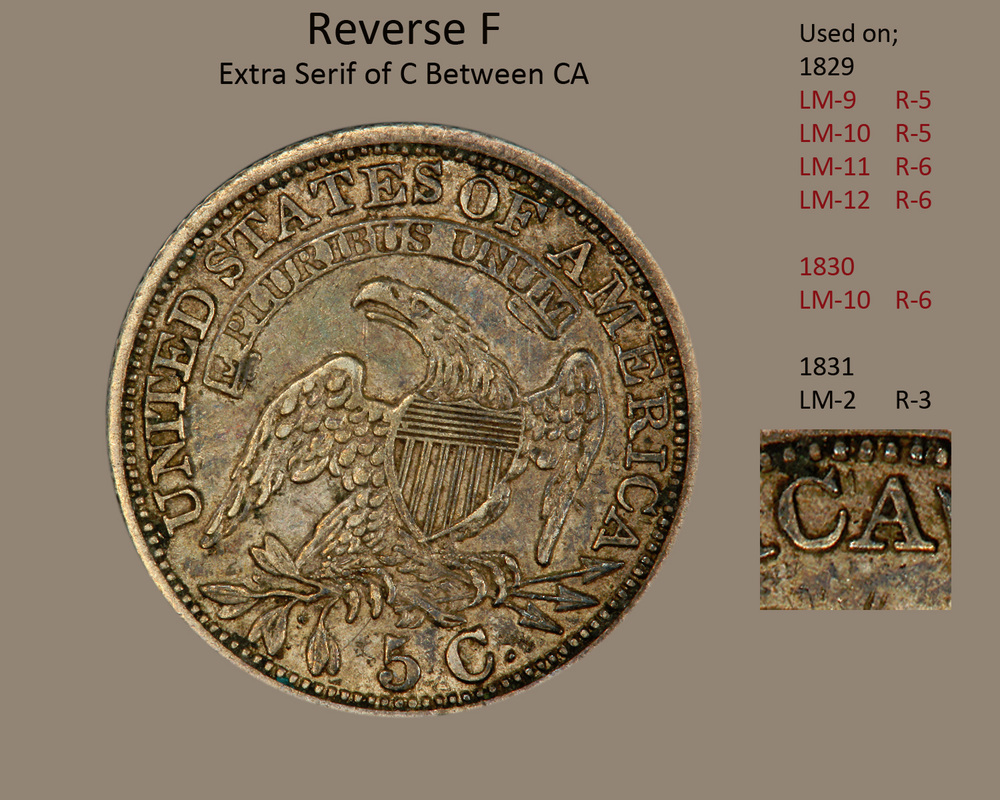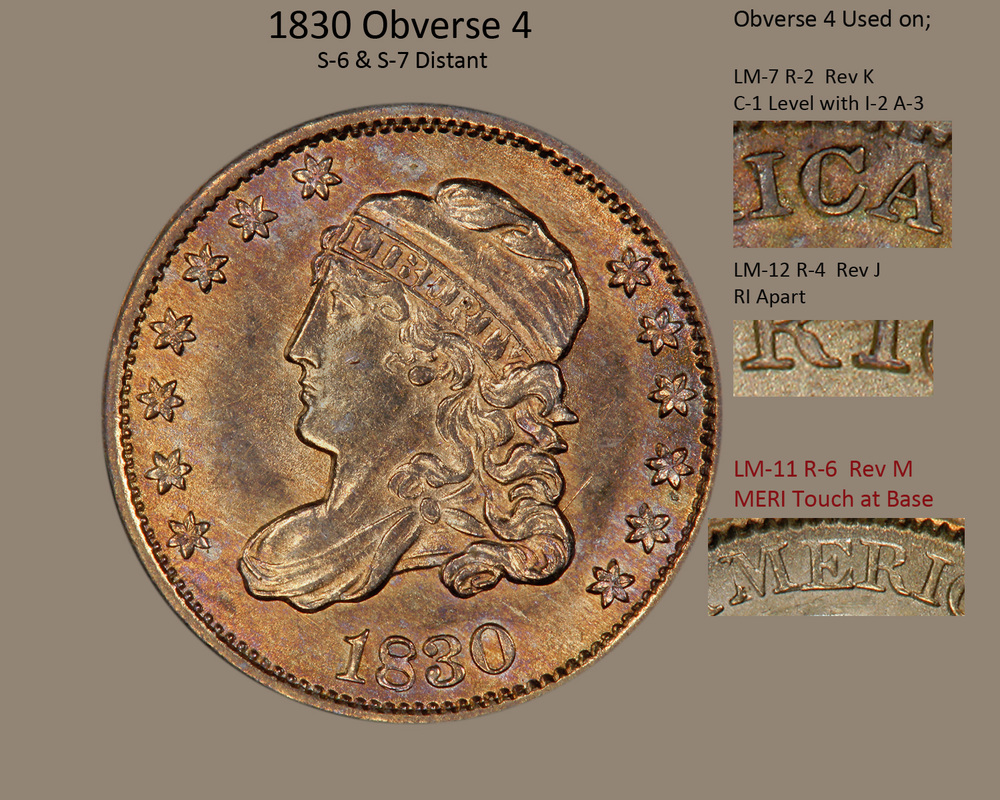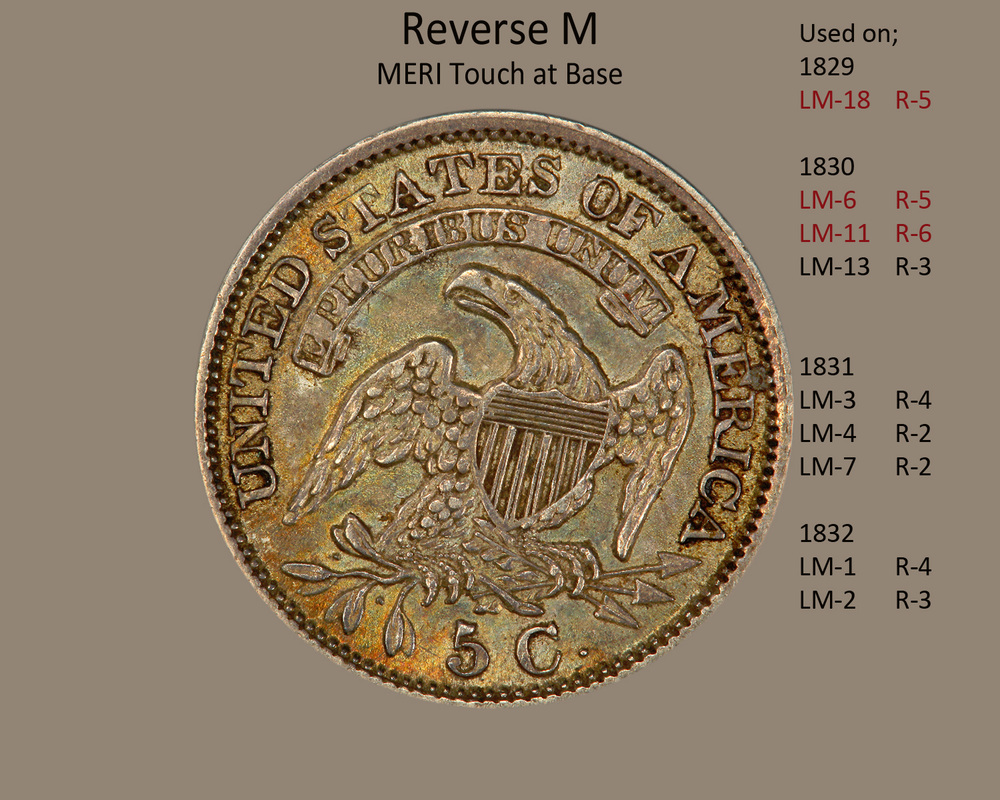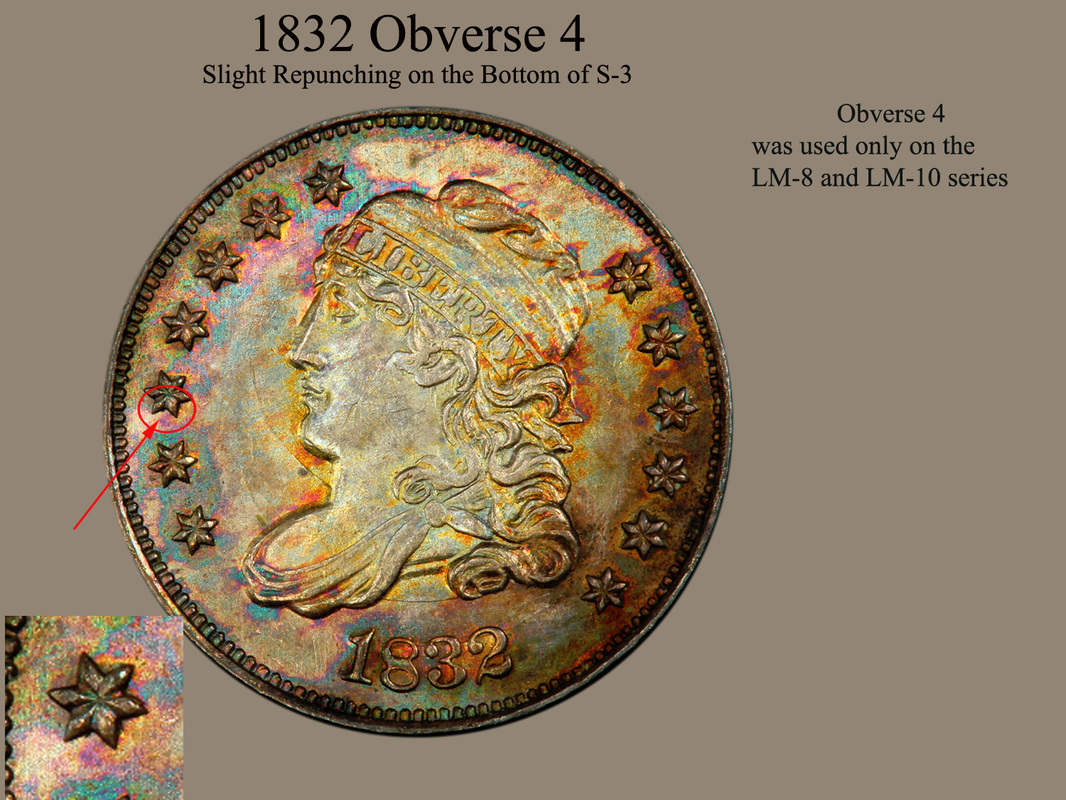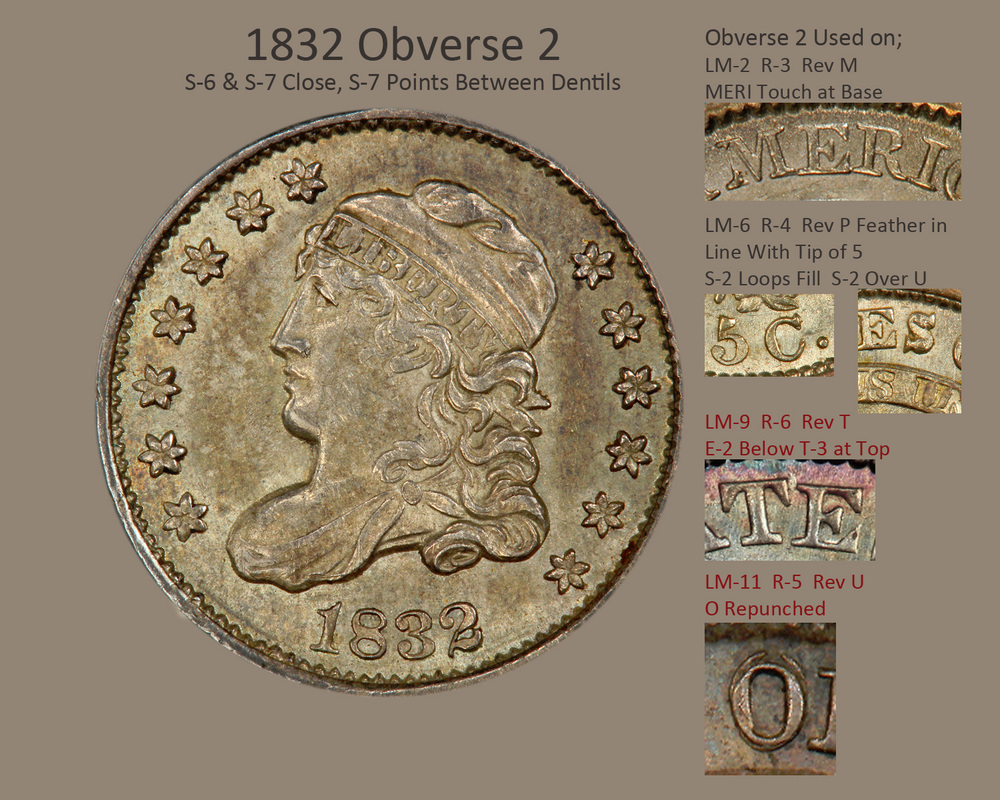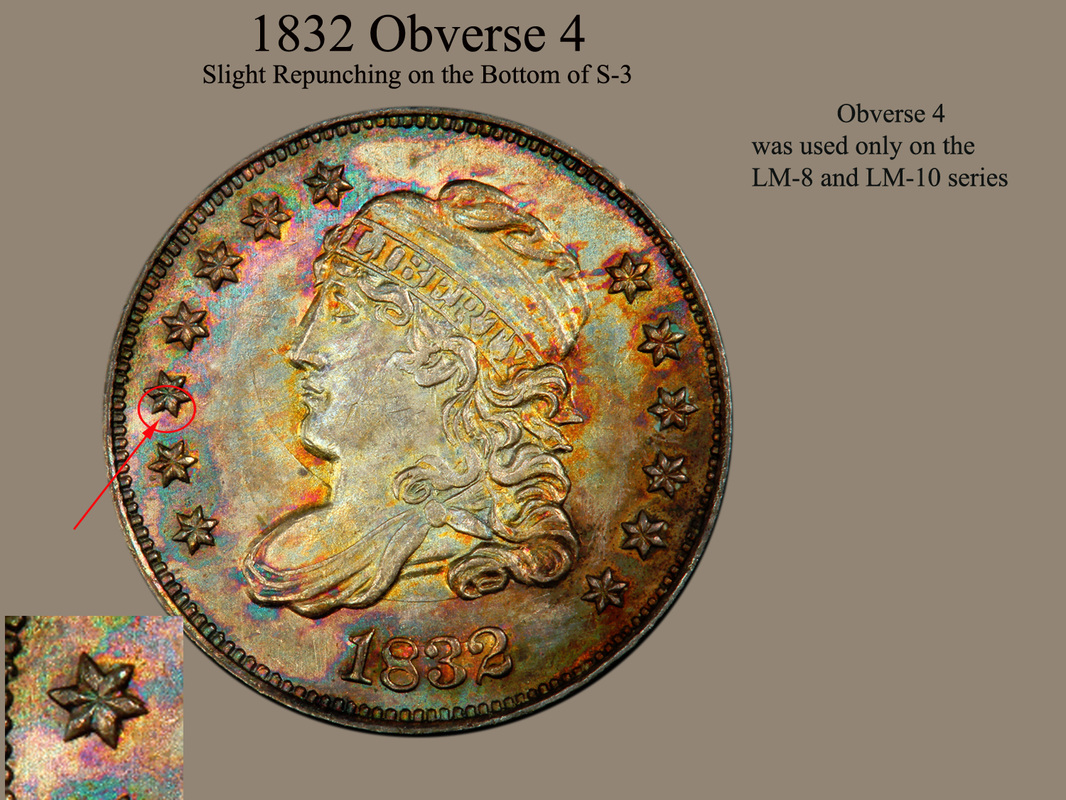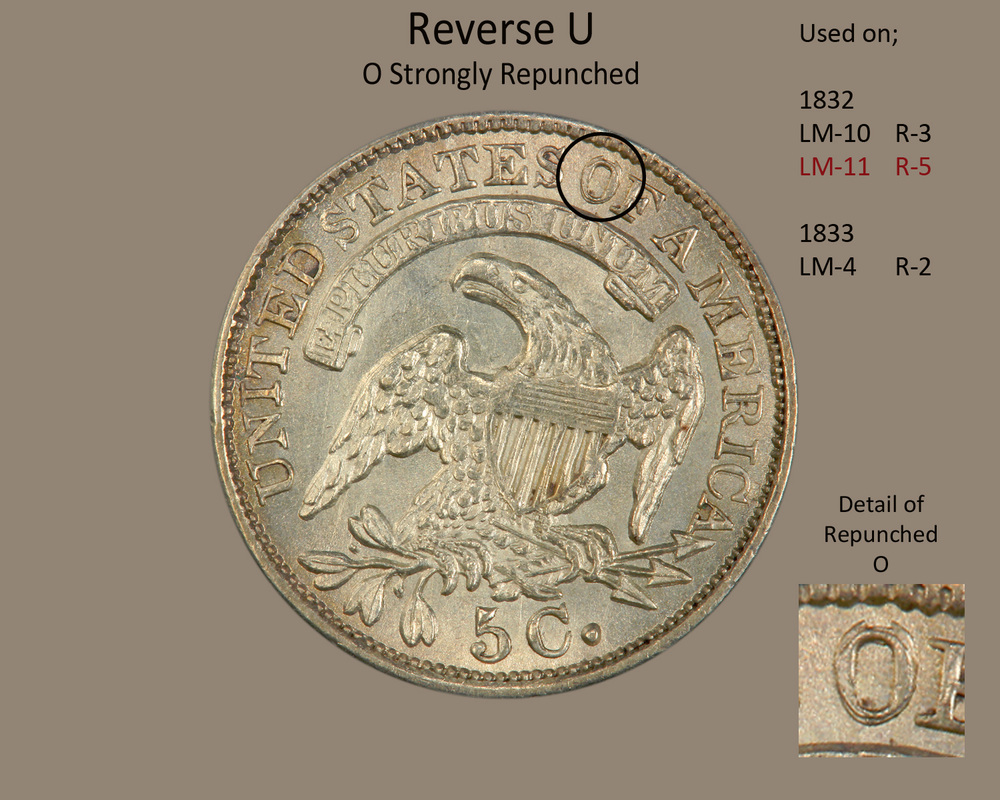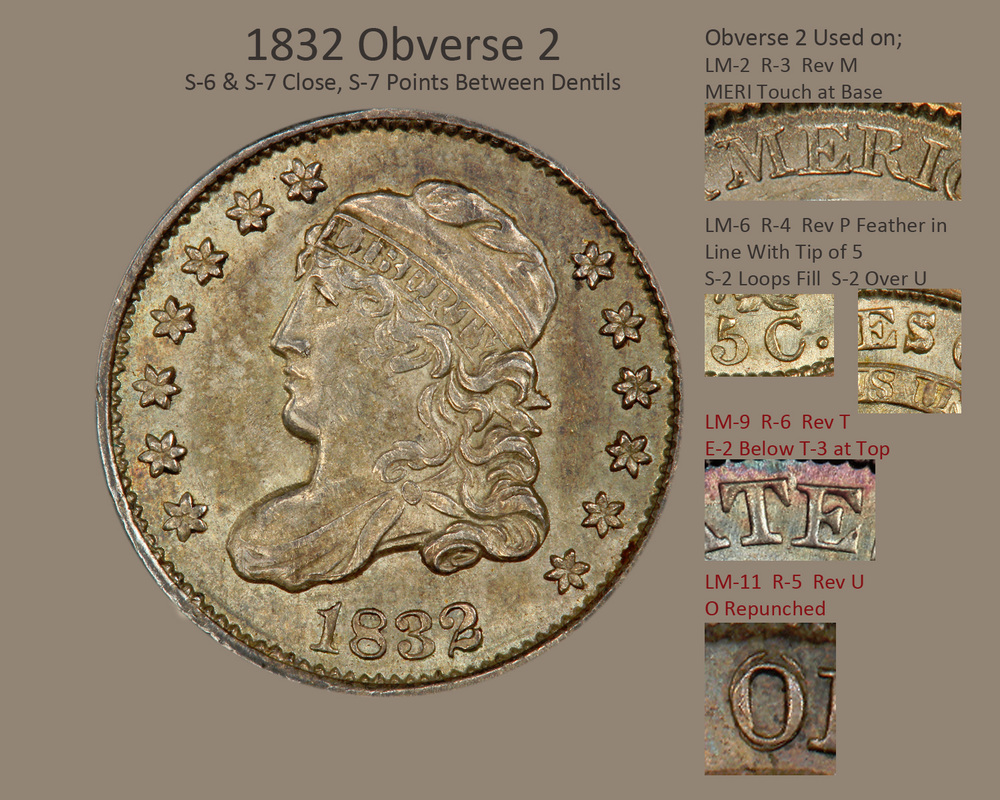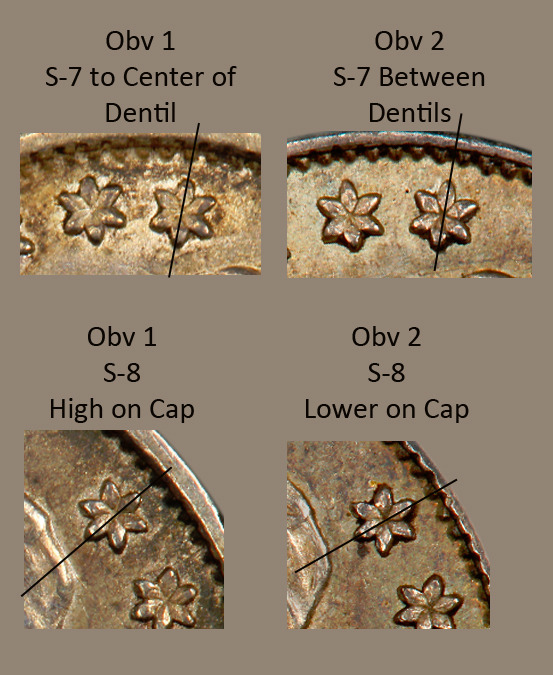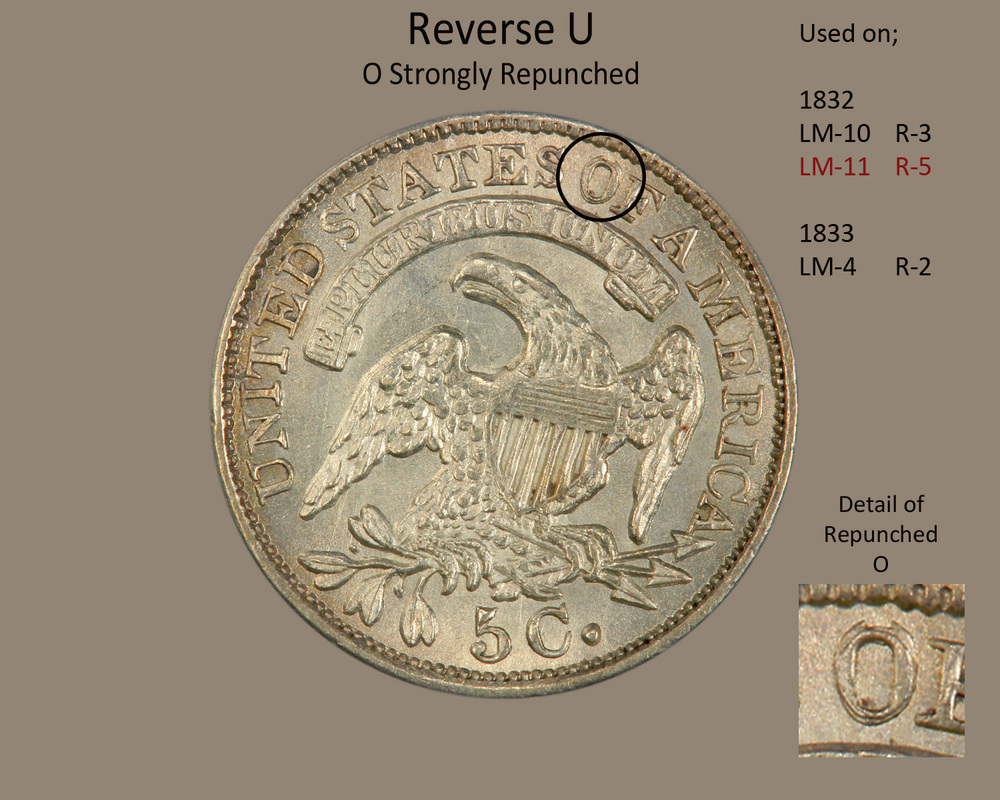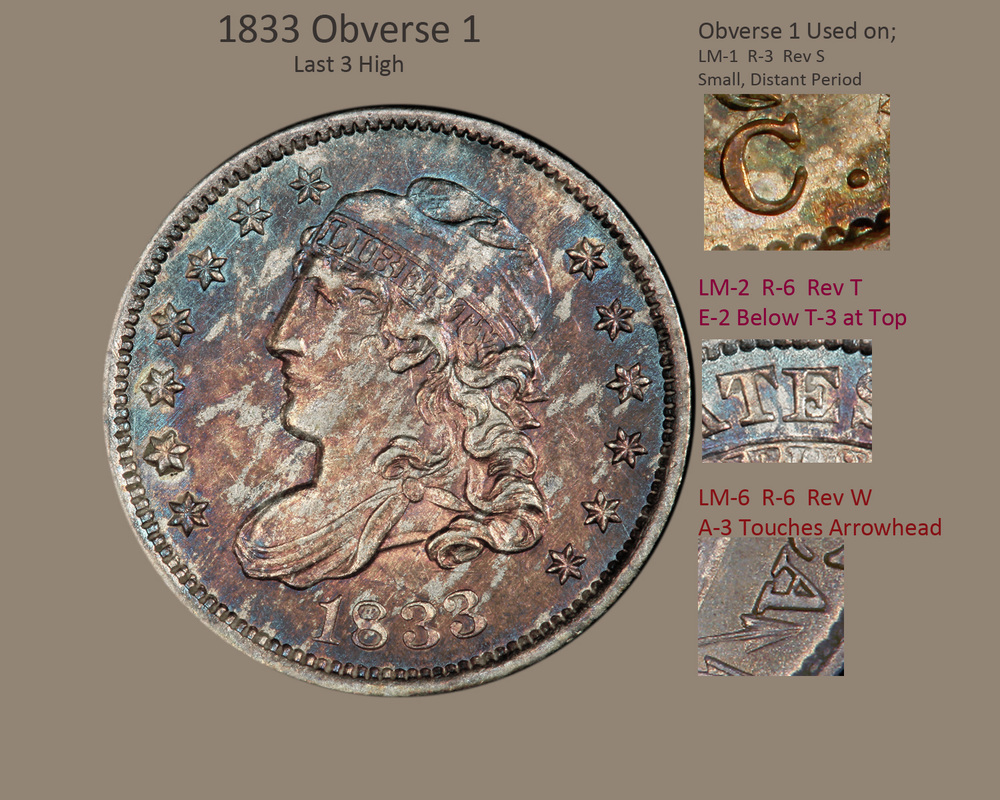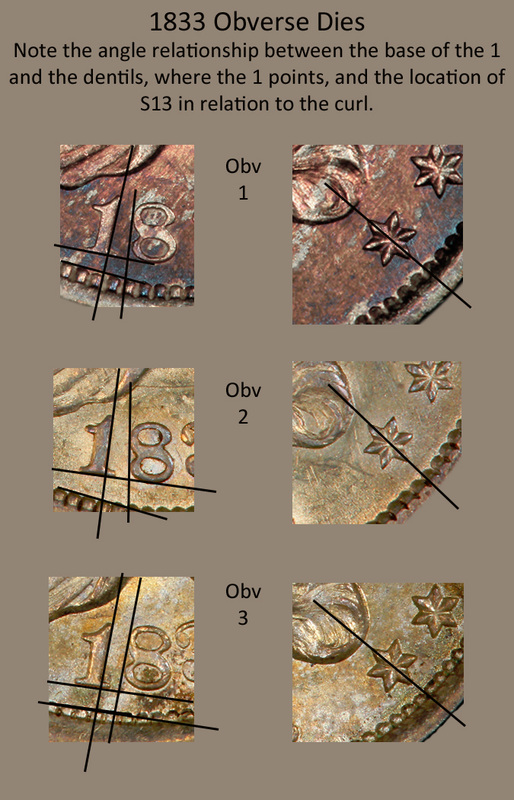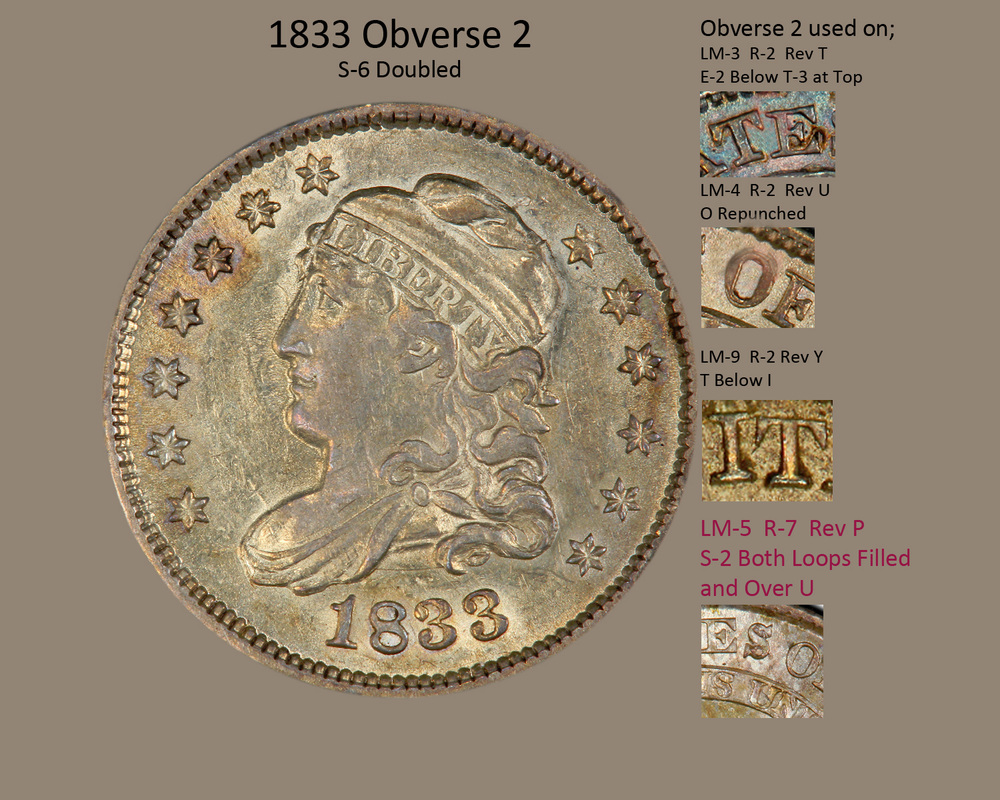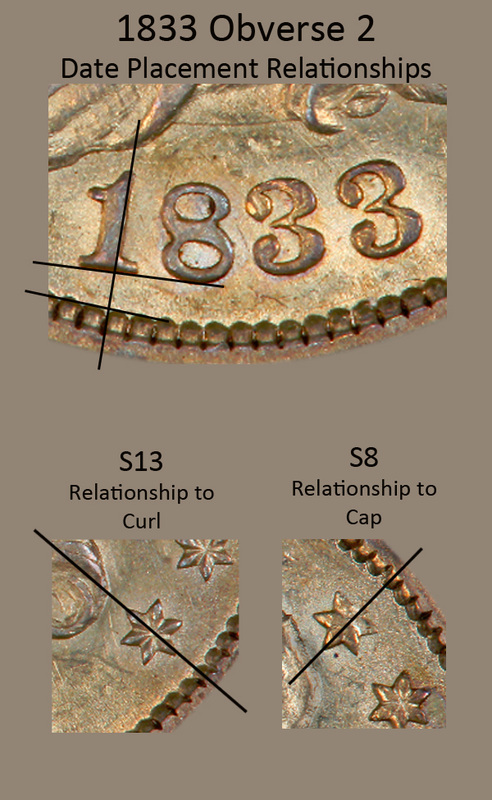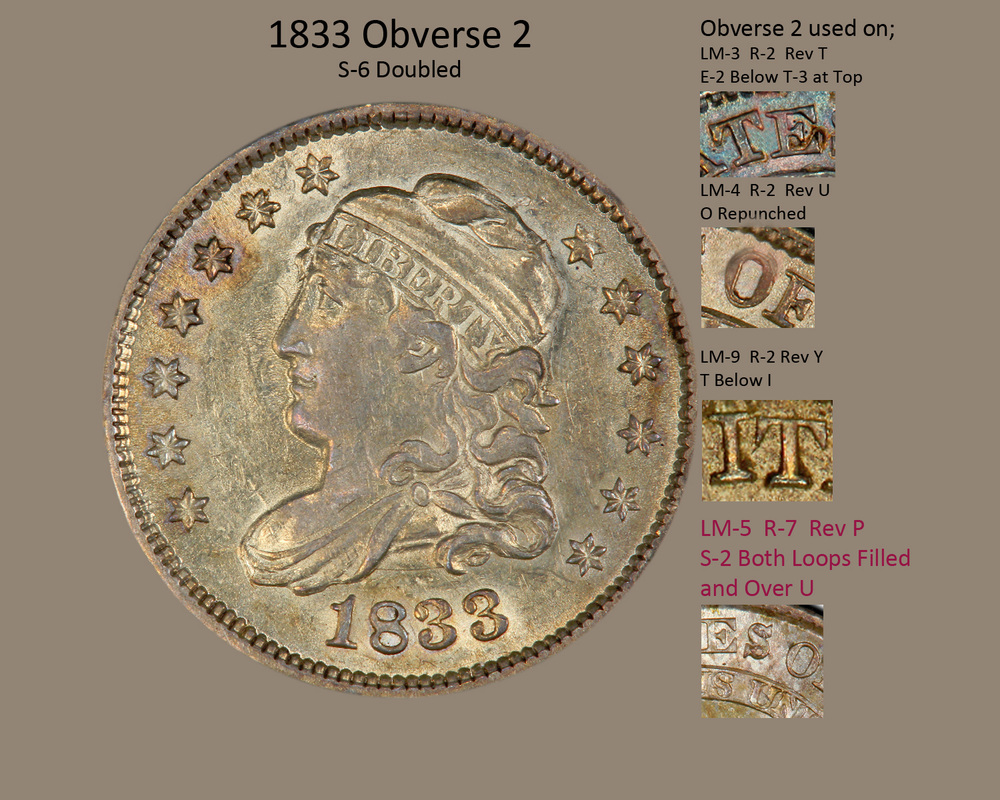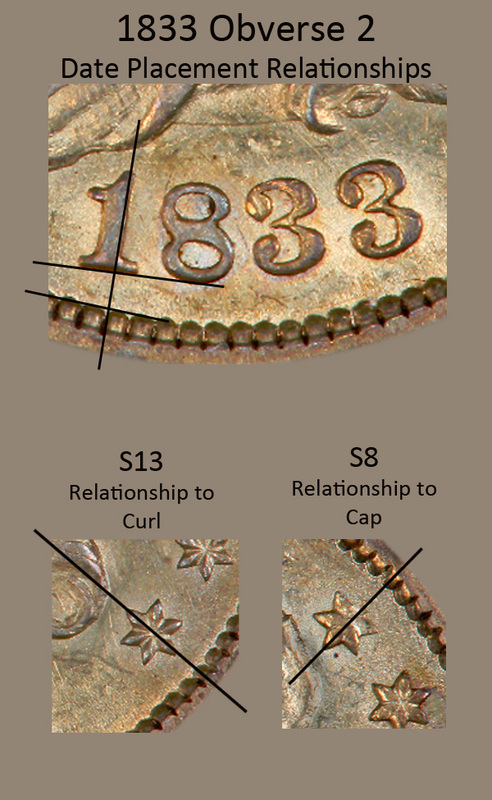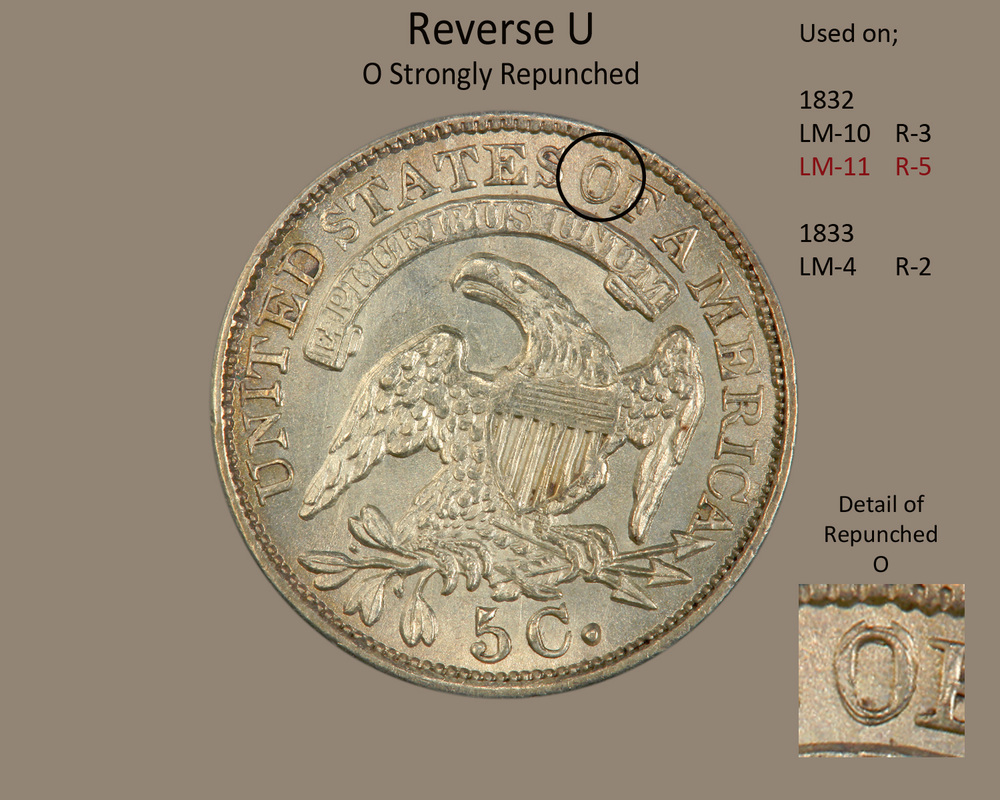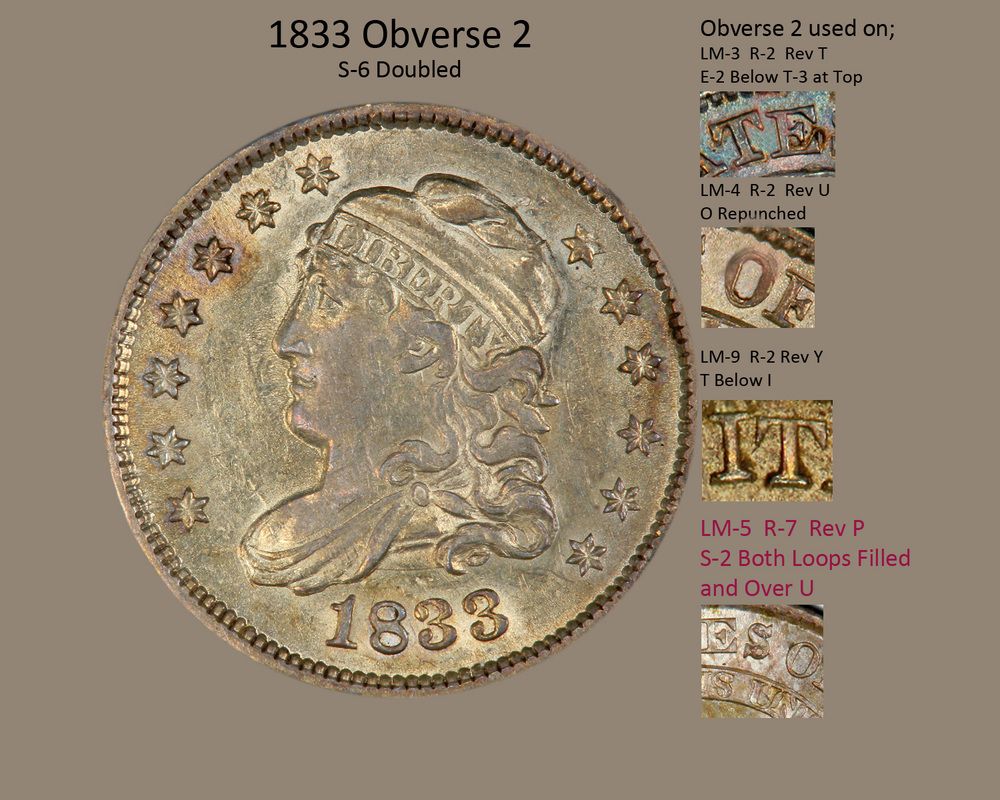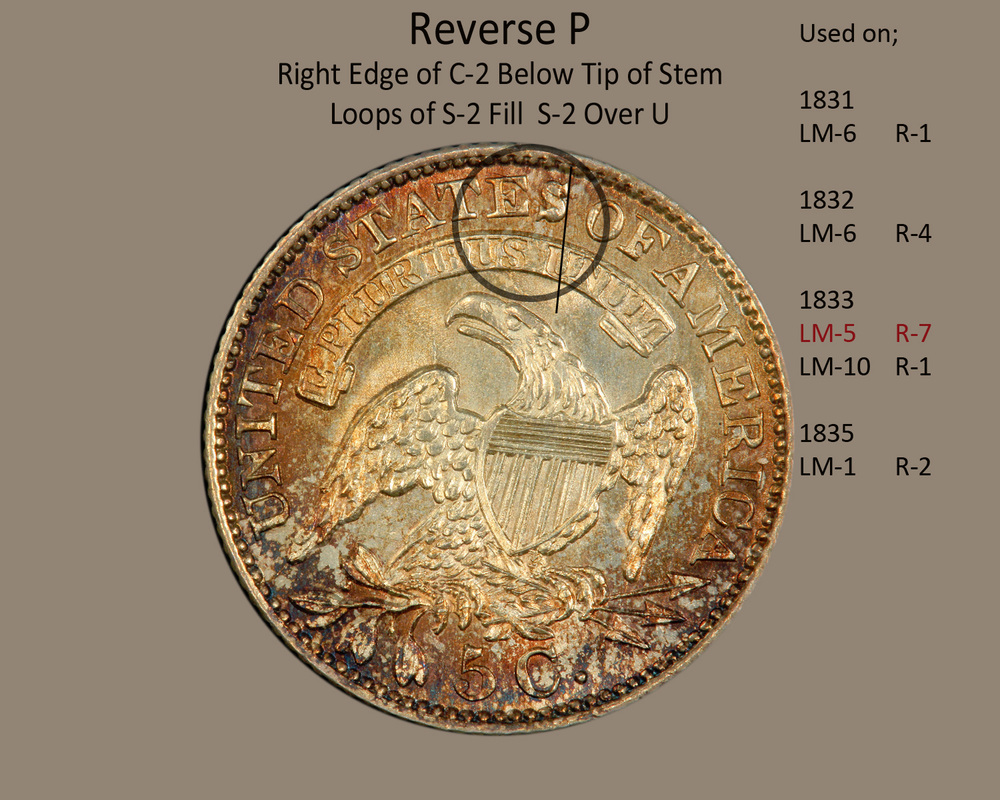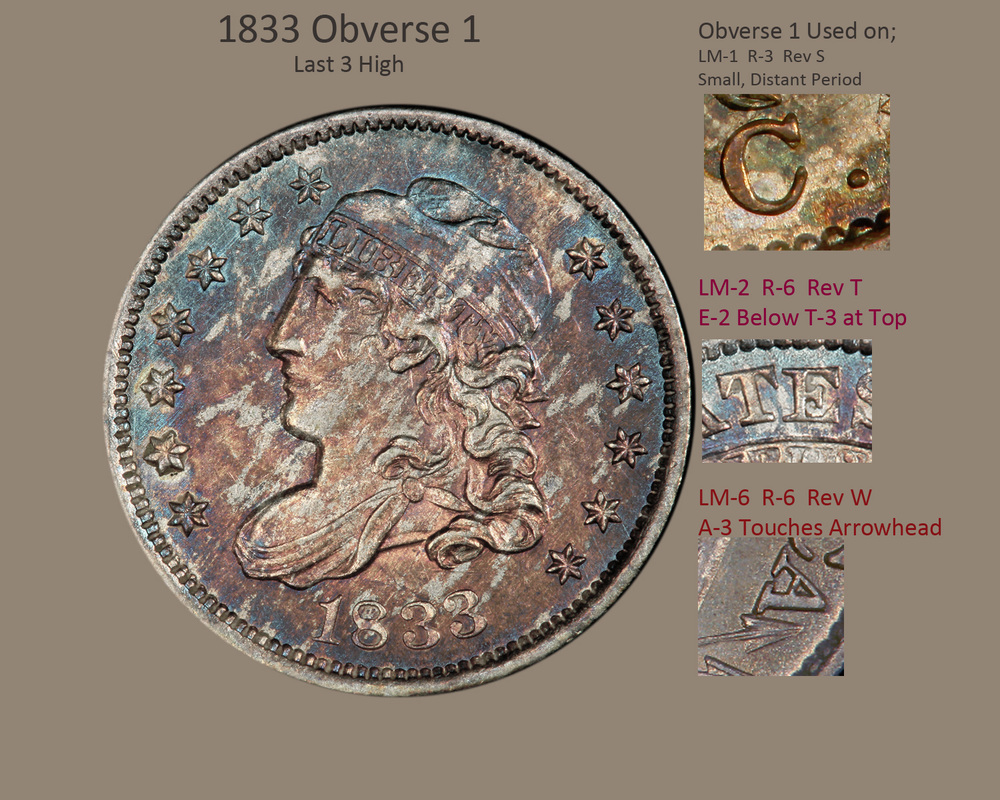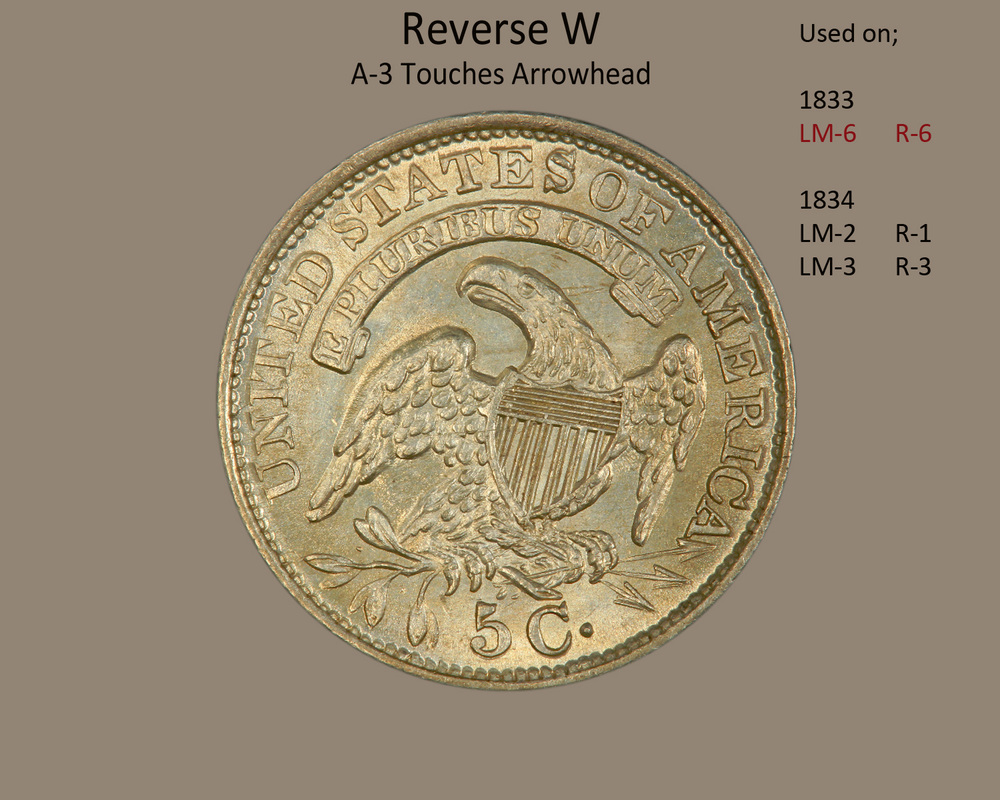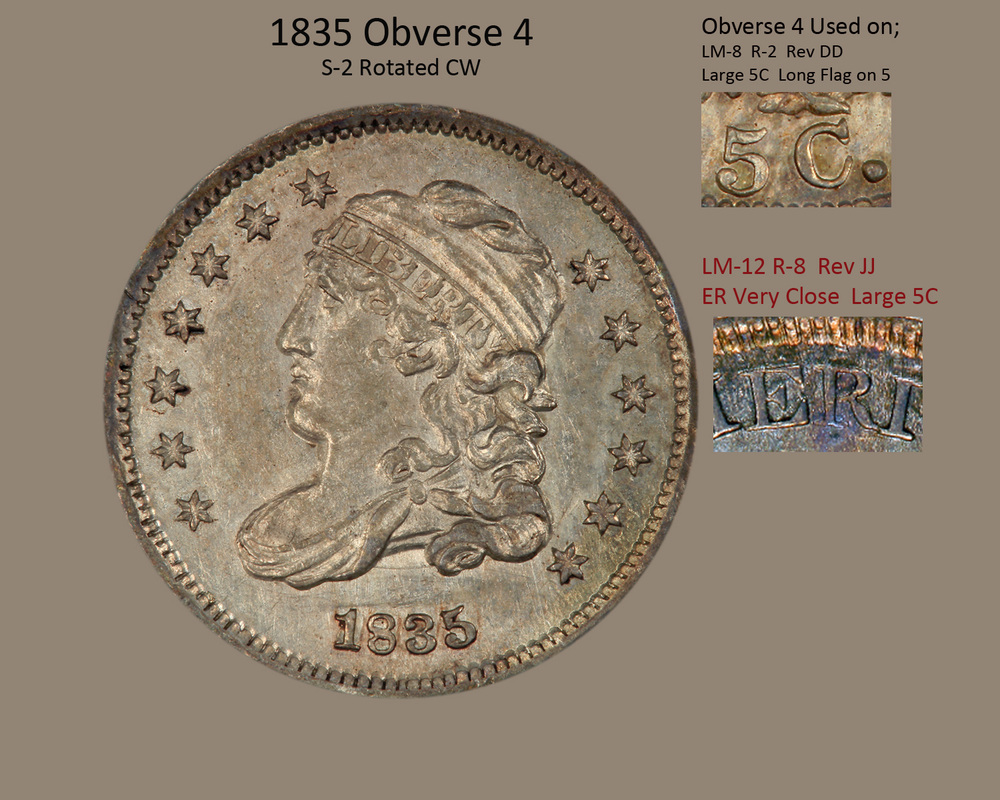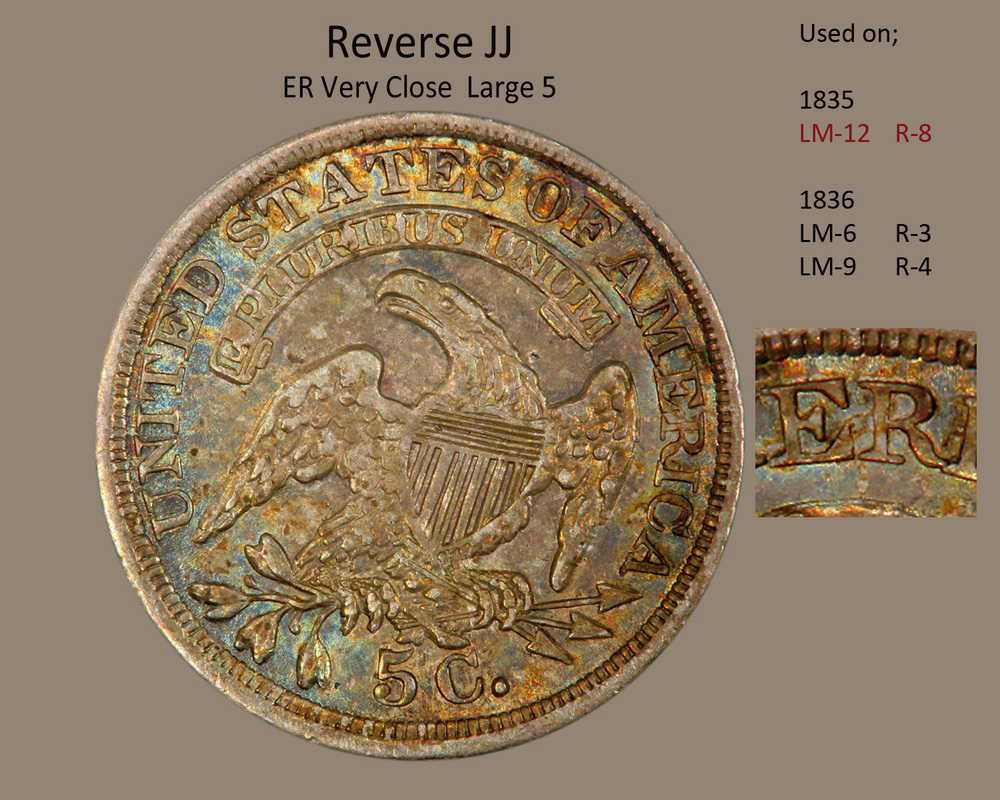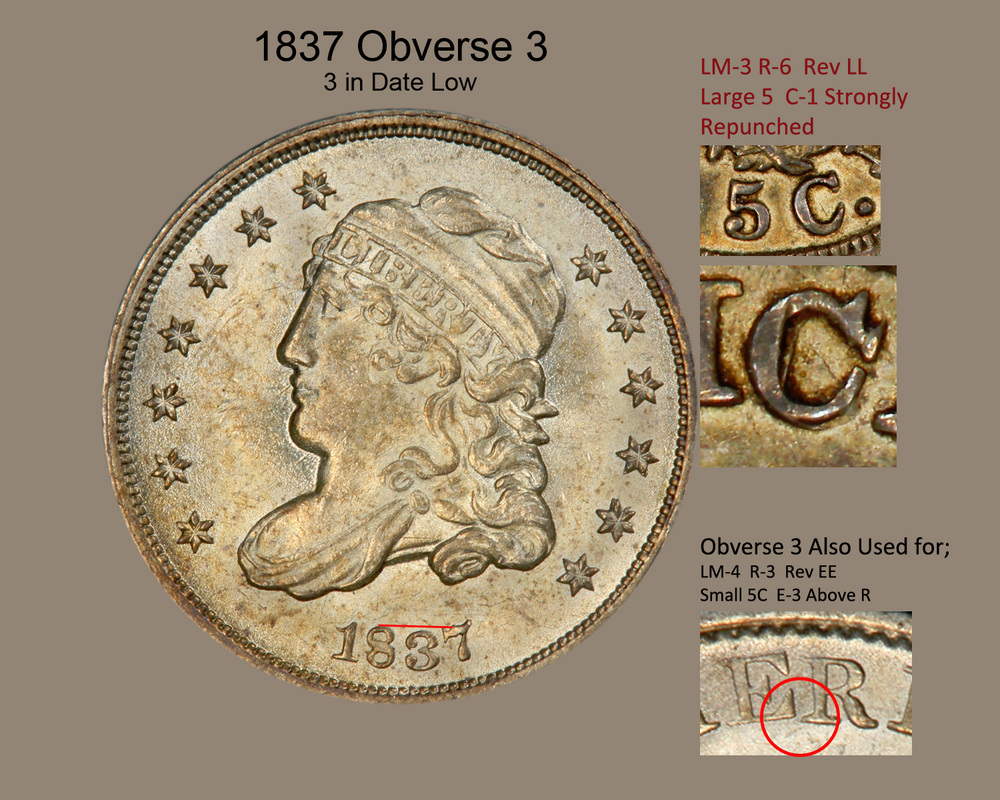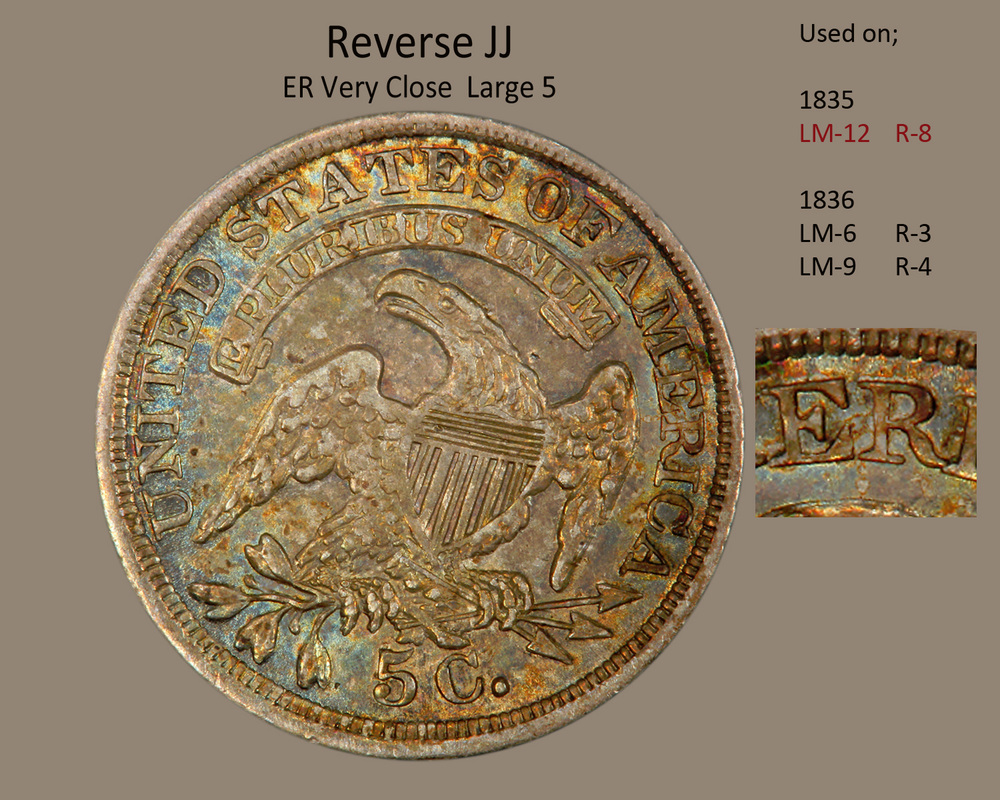A brief Primer on Re-Marriages
200 years ago coin dies were expensive and hard to make. Back then when a die became damaged it would be pulled, repaired and placed back in service. Remember too that at times obverse dies with dates may have been used after the date on the coin. No sense throwing away a perfectly good obverse die just because it has the wrong date on it!
Using reverse E as an example we'll show how this worked.
Reverse E was first used in 1829 paired with the obverse 4 die which created the 1829 LM-6.1. At some point the obverse 4 die was pulled and replaced with an obverse 5 die (creating the LM-7 variety) and mintage continued. At some point the obverse 5 die was pulled and replaced by the obverse 4 die used earlier creating the LM-6.2. By this point the E reverse die was showing some degradation with the first diagonal of the N filling with a die chip. Also seen is a small cud above M and a die crack forms from the rim through the top of E 3. For the purposes here, discussions on remarriages are brief. For more in depth discussion on remarriages please see the Logan - McCloskey book, "Federal Half Dimes 1792-1837".
Using reverse E as an example we'll show how this worked.
Reverse E was first used in 1829 paired with the obverse 4 die which created the 1829 LM-6.1. At some point the obverse 4 die was pulled and replaced with an obverse 5 die (creating the LM-7 variety) and mintage continued. At some point the obverse 5 die was pulled and replaced by the obverse 4 die used earlier creating the LM-6.2. By this point the E reverse die was showing some degradation with the first diagonal of the N filling with a die chip. Also seen is a small cud above M and a die crack forms from the rim through the top of E 3. For the purposes here, discussions on remarriages are brief. For more in depth discussion on remarriages please see the Logan - McCloskey book, "Federal Half Dimes 1792-1837".
|
|
Listed to the left are the rarest 25 die marriages both by date and by R factor.
Rarity Rating R-4 = 76 to 200 Pieces Known R-5 = 31 to 75 Pieces Known R-6 = 13 to 30 Pieces Known R-7 = 4 to 12 Pieces Known R-8 = 1 to 3 Pieces Known The "Holy Grail" in the series is the 1835 LM-12 of which just 3 to 4 pieces exist followed closely by the 1830 LM-1.1 with 3 known pieces and the 1833 LM-5 with only 5 known examples. |
1829 LM-6.1 R-7, LM-6.2 R-5, LM-6.3 R-5
The 1829 LM-6 varieties combines obverse 4 with reverse E
| Identifing the 1829 LM-6 Varieties | 6.1 | 6.2 | 6.3 |
|---|---|---|---|
| Strong devices, both berries have stems | yes | yes | yes |
| First diagonal of N fills | No | yes | yes |
| Small cud starts to form above M into dentils | No | yes | yes |
| Top loop of S-2 fills. Die crack forms from | |||
| left wing tip to rim | No | No | yes |
| Large die chip forms in second angle of N and a | |||
| die crack forms from rim to top of E-3 & across to R | No | No | yes |
1829 LM-8 R-6
The 1829 LM-8 R-6 combines obverse 2 with reverse E
1829 LM-11 R-6
The 1829 R-6 LM-8 combines obverse 2 with reverse F
1829 LM-12 R-6
The 1829 R-6 LM-12 combines Obverse 5 with Reverse F
1830 LM-1.1 R-8
The 1830 LM-1.1 R-8 combines obverse 1 with reverse G
| Identifying the 1830 LM-1 Varieties | LM-1 | LM-2 |
|---|---|---|
| Die crack forms from tip of right wing to | ||
| arrow shafts | No | Yes |
| Die crack forms from the base of A-2 to F | No | Yes |
| Cuds form at top of A-2 and through tops | ||
| of ERI | No | Yes |
1830 LM-5 R-6
The 1830 LM-5 R-5 combines obverse 1 with reverse J
1830 LM-9.2 R-5
The 1830 LM-9.2 R-5 combines obverse 5 with reverse L.
Differentiations between the LM-9.1 and LM-9.2
Differentiations between the LM-9.1 and LM-9.2
| 9.1 | 9.2 | |
|---|---|---|
| Top loop of S-1 & S-2 Filled | No | Yes |
| Top right of T-1 filled | No | Yes |
| M fills between right upright and Diagonal | No | yes |
| Die crack appears at tops of UNIT | No | Yes |
| Die crack appears from Scroll end to top of | No | Yes |
| right wing over to E-3 | ||
| Die crack begins to form from left wing tip | No | Yes |
| to olive branches then to rim |
1830 LM-10 R-6
The 1830 LM-10 R-6 combines obverse 5 with reverse F
1830 LM-11 R-6
The 1830 R-6 LM-11 combines obverse 4 with reverse M
1832 LM-8.2 & LM-8.3 R-5
| Identifing the 1832 LM-8 Varieties | 8.1 | 8.2 | 8.3 | 8.4 | 8.5 |
|---|---|---|---|---|---|
| 1st use of T reverse, strong rim and dentils | Yes | No | No | No | No |
| 5th use of T Die swelling hides BU in PLURIBUS | No | Yes | No | No | No |
| Top loop of S-2 starts to fill | No | Yes | |||
| Top loop of S-2 filled | No | No | Yes | Yes | Yes |
| Die crack appears from E-1 through scroll, | |||||
| through eagle's head to scroll below N | No | Yes | Yes | Yes | Yes |
| Top loop of S-1 filled | No | No | Yes | Yes | Yes |
| Die chip forms between right upright and | |||||
| diagonal of N | No | No | Yes | Yes | Yes |
| Die cracks appear at base of UNIT ES MERIC | No | No | No | Yes | Yes |
| More die cracks appear from rim to M, F to rim | |||||
| and from right wingtip passing through | |||||
| arrows to rim | No | No | No | Yes | Yes |
| Die crack at bottom of IT enlarges and joins IT | No | No | No | No | Yes |
| N fills between right upright and diagonal | No | No | No | No | Yes |
| Die chip forms in D | No | No | No | No | Yes |
The 1832 LM-8.2 & 8.3 R-5 combines obverse 4 with reverse T
1832 LM-9.1 R-6 & LM-9.2 R-7
| Identifing the 1832 LM-9 Varieties | 9.1 | 9.2 |
|---|---|---|
| Top Loop of S-2 Filled | No | Yes |
The 1832 LM-9.1 R-6 and LM-9.2 R-7 combines obverse 2 with reverse T
1832 LM-10.2 R-6 & LM-10.3 R-5
| Identifing the 1832 LM-10 Varieties | 10.1 | 10.2 | 10.3 | 10.4 |
|---|---|---|---|---|
| Die chip between right upright and diagonal of N | No | Yes | Yes | Yes |
| Die crack from left wingtip to dentils | No | No | Yes | Yes |
| Die crack from from top of A-2 to M in scroll | No | No | Yes | Yes |
| Monster cud developes over TES OF A | No | No | No | Yes |
The 1832 LM-10.2 R-6 and LM-10.3 R-5 combines obverse 4 with reverse U
1832 LM-11.1 R-5
| Identifing the 1832 LM-11 Varieties | 11.1 | 11.2 |
|---|---|---|
| Die crack from left wingtip to dentils | No | Yes |
The 1832 LM-11 R-5 combines obverse 2 with reverse U
1833 LM-2 R-6
The 1833 LM-2 combines obverse 1 with reverse T
1833 LM-3.5 R-7
The 1833 LM-2 combines obverse 2 with reverse T
| Identifing the 1833 LM-3 Varieties | 3.1 | 3.2 | 3.3 | 3.4 | 3.5 |
|---|---|---|---|---|---|
| Upper loop of S-2 filled | No | Yes | Yes | Yes | Yes |
| Die chip begins to form between upright and | |||||
| center bar of E-1 | No | No | Yes | Yes | Yes |
| Die cracks form between right wing tip through | |||||
| arrows to rim and from rim to top of A-3 | No | No | No | Yes | Yes |
| Large cud covers NIT and portion of E | No | No | No | No | Yes |
1833 LM-4.3 R-5
The 1833 LM-4.3 combines obverse 2 with reverse U
| Identifing the 1833 LM-4 Varieties | 4.1 | 4.2 | 4.3 |
|---|---|---|---|
| Die chip forms between diagonal and right | |||
| upright of N | Yes | Yes | Yes |
| die crack forms from left wing tip to dentils | No | Yes | Yes |
| Cud forms top of scroll to F A | No | No | Yes |
1833 LM-5 R-7
The 1833 LM-5 combines obverse 2 with reverse P
1833 LM-6 R-6
The 1833 LM-1 combines obverse 1 with reverse W
1835 LM-12 R-8
The 1835 LM-12 combines obverse 4 with reverse JJ
1837 LM-3 R-5
The 1837 LM-3 combines obverse 3 with reverse LL
